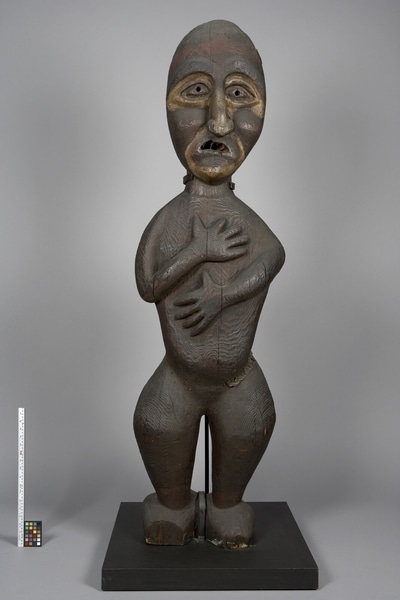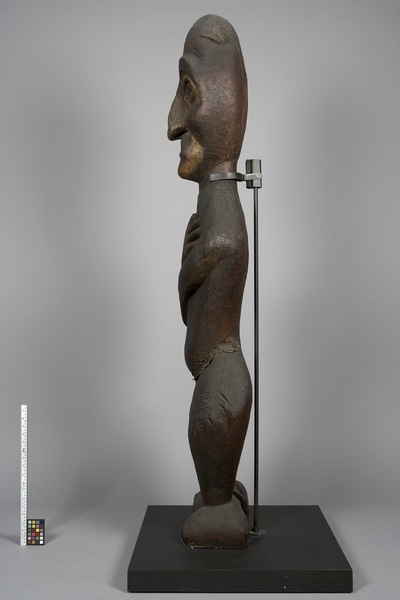Grave Figure Item Number: A1781 from the MOA: University of British Columbia



Description
Carved wooden standing figure. Represents a male with his right hand on his breast and his left hand on his abdomen. Face carved in relief, wide downturned nose, open mouth, large deep eyes and heavy brows. Remnants of skin and hair on head nailed to head. Light brown paint around eyes, nose and jaw, also traces of white paint around mouth, nose and eyes. Formerly had hair and eyebrows of bear fur. Faint red band around forehead. Also strip of hairless skin on right groin.
History Of Use
Stylistic attributes suggest this carving would have been a mortuary figure. In his description of Coast Salish grave figures, anthropologist Paul S. Wingert notes that they: "have long oval heads, thin columnar necks, and sloping shoulders. [They] also have tapering torsos, well marked groin lines, and similarly carved hands and fingers... [Facial features have] individualistic details [such as] high pointed nose and deep creases at the sides of the mouth and higher forehead and long broken nose (1949:42)."
Cultural Context
mortuary
Narrative
Said to have been found by Raley in the Fraser River at Sardis, BC, during a flood (along with A1780). However the pair of figures are shown standing together outdoors, in a photo taken at Tis'kwat in Powell River (photo 2014.9.13, from the qathet Museum & Archives). Two men are also shown in the photo. One is Jose Gallegos from Chile, who jumped ship in Vancouver. He is said to have met a Tla'amin woman in the hop fields in Chiliwack. They then moved to Powell River and were married. (The BC Archives has a marriage certificate for Joseph Gallegos and Mary Atum in Comox in 1898). It is currently unknown how the mortuary figures would have ended up in Sardis.
Item History
- Made in Powell River, British Columbia, Canada ? between 1850 and 1900
- Collected in Sardis, British Columbia, Canada between 1893 and 1934
- Owned by George H. Raley before November 1948
- Received from H. R. MacMillan (Funding source) and George H. Raley (Seller) during November 1948
What
Who
- Culture
- Coast Salish: Tla'amin
- Previous Owner
- George H. Raley
- Received from
- H. R. MacMillan (Funding source) and George H. Raley (Seller)
Where
- Holding Institution
- MOA: University of British Columbia
- Made in
- Powell River, British Columbia, Canada ?
- Collected in
- Sardis, British Columbia, Canada
When
- Creation Date
- between 1850 and 1900
- Collection Date
- between 1893 and 1934
- Ownership Date
- before November 1948
- Acquisition Date
- during November 1948
Other
- Item Classes
- carvings & sculpture
- Condition
- fair
- Current Location
- Case 6
- Accession Number
- 1960/0186